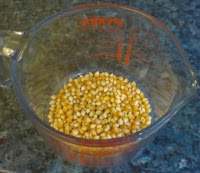 Popcorn is a popular snack which is often recommended as a healthy choice for dieters. It’s filling, high in fibre, low in fat and takes ages to eat.
Popcorn is a popular snack which is often recommended as a healthy choice for dieters. It’s filling, high in fibre, low in fat and takes ages to eat.But not all popcorn can be classed as healthy. In fact, according to research undertaken by consumer group, Which?, a typical tub of popcorn sold at the cinema contains 1,260 calories and has 79.6g of fat. This alone is more than the recommended daily maximum fat allowance for women. So how can you tell which popcorn is healthy and which is a health hazard?
Why Popcorn is Good for Dieting
Popcorn has the benefit of being a wholegrain food which means it contains more fibre than many other popular snack foods. Air popped popcorn has no saturated fat, no cholesterol and has minimal amounts of sugar. Weight for weight, the calories in popcorn are lower than most other popular snacks. And because of its fibre content, popcorn is filling. For example, 8 grams of popcorn, which is roughly one cup, has around 30 calories.
However, 8 grams equates to just 7 or eight 8 crisps or 4 chocolate Maltesers, both of which have just over 40 calories. Two or three cups of popcorn can be enough to satisfy hunger and snack cravings, which makes it a great choice for including in a diet.
The photo on the left shows 50g of popcorn kernels which have 186 calories according to the brand of corn used. Once they’ve been popped, they’ve expanded to make enough for six cups of popcorn, (as shown on the right) still at 186 calories, as long as no oil has been used to cook them and nothing is added. So a filling snack of 3 cups of popcorn would be worth under 100 calories. Not bad at all.
|
|
What Makes Popcorn Unhealthy?
Unfortunately, unless you make popcorn yourself, the majority of prepared popcorn you’re likely to come across, will be high in fat, salt, sugar and calories. This is mainly due to the addition of flavourings such as toffee or butter and the oil which it’s cooked in. A 100g pack of butter toffee popcorn as sold in supermarkets nets you around 405 calories, 7.7g of fat, 4.3g fibre, 2.2g protein and 81.7g of carbohydrates.
How to Make Healthy Popcorn
Air popping is the healthiest way to cook popcorn. Because this method avoids the need for cooking in oil, which has at least 100 calories a tablespoon, you’ll be saving around 100-200 calories straight off. To air pop your corn, you can use a special popcorn maker. They’re simple to use and range in price from as little as £18 up to £350 for a standalone popcorn maker complete with cart, though this one is probably more suited to promotional events.
Alternatively, you can use a paper bag or a microwave safe container with lid and cook it in the microwave instead. All you need to do it put a few tablespoons of popcorn kernels into the bag or container and cook on high. If using a bag, ensure it's folded over a few times at the top with enough room left for expansion. Or, if using a microwave safe container, place a lid on top but leave it unsealed. Whichever method you use, it takes around the same amount of time as when using the stove top method.
Although air popped corn is healthiest just on its own, it’s usually a little too plain for the majority of palates and isn't as tasty as shop or cinema bought varieties. So, to keep your popcorn as healthy as possible, avoid adding extras such as butter, oils, sugar, salt, butterscotch or toffee. Instead, try sprinkling it with a sweetener such as Stevia. If you find it doesn’t stick properly, lightly spray the popcorn with a little Frylight oil spray or similar, then sprinkle with sweetener.
Popcorn is a healthy, filling and low fat snack which can easily be included in a healthy, weight loss diet. However, take care to avoid those ready-made varieties which are so often laden with unhealthy fat, sugar, salt and calories. It’s easier, cheaper and a lot more fun making your own healthy popcorn at home in just a few minutes.
© Diets and Calories



why on earth do you suggest avoiding sugar but then say to uuse icing sugar?
ReplyDeleteGood point! What was I thinking? Suggestion removed.
Delete